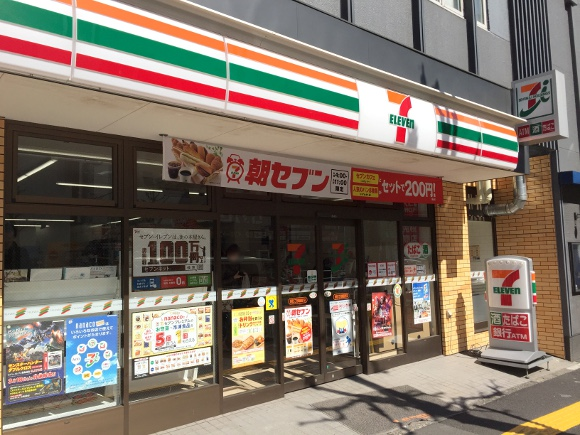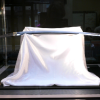
Help keep Japan’s convenience stores convenient by learning and following these six Japanese etiquette points.
The esoteric nature of Japanese etiquette is something that’s often exaggerated by foreign observers, but it’s still accurate to say that Japan strongly considers being considerate a critical responsibility for any non-infant member of society. That goes double for places where large numbers of people gather, such as convenience stores.
Since many convenience store customers are in a hurry, the industry has devised various systems and pieces of equipment to streamline the process of getting in and out of the store as smoothly as possible. However, not everyone is observant enough to utilize these, prompting frustrated Japanese Twitter users to give examples of “things idiots can’t see” in convenience stores.
1. The tray idiots can’t see
Starting things off was @gyoniku_sanaari, who referenced fairy tale The Emperor’s New Clothes while saying:
“I don’t know if there really are clothes that are invisible to stupid people, but I know this is a tray that idiots can’t see.”
「バカには見えない服」が実際にあるかは知らないけど、「バカには見えない皿」なら知ってる。 pic.twitter.com/kw0Z5IJ3ha
— 🇫🇷*魚肉☁️⭐️ (@gyoniku_sanaari) June 12, 2018
@gyoniku_sanaari, who might be a convenience store clerk speaking from frustrated experience, doesn’t mean for his words to be taking literally. Instead, he’s expressing exasperation that many customers either don’t notice, or don’t properly use, the tray in question. Of course, even SoraNews24’s intelligent and mannerly readers might not know what it is if they’ve never been in a Japanese convenience store, so what is it?
It’s a tray to put your coins in when you pay for your purchase. In Japan, the smallest bill is 1,000 yen (US$9.20), which means that just about any transaction at a convenience store is going to involve paying with at least a few coins, and instead of handing them directly to the cashier, you’re supposed to toss them into the tray, which has rubberized pips to make it easier for the clerk to scoop them up, as well as angled sides to keep them in the same general area as they’re being counted.
▼ Some coin trays are raised, as opposed to sitting on the counter.
https://twitter.com/____ETO____/status/10068036905551339522. The box idiots can’t see
So what else do Twitter users say “idiots” fail to see in convenience stores? This little box, which like the coin tray, is often located near the register.
私も知ってる pic.twitter.com/a0ChFClO3K
— 𝓞𝓣𝓐𝓚𝓐𝓣𝓤𝓐𝓚𝓐 (@chiharu_365) June 13, 2018
It’s a receptacle for unwanted customer receipts. Though the store is required to give you one, odds are you don’t really need to keep written proof of your lawful purchase of that bag of sweet bean-flavored potato chips, but rather than leave it on the counter and making it trash for the clerk to have to pick up, you’re supposed to place it in the box, which may be labeled in Japanese text with 不要レシート入れ (“Place unneeded receipts here”).
3. The sign idiots can’t see
Speaking of Japanese text…
ちなみに馬鹿には見えない看板も pic.twitter.com/Ea9xM23euQ
— そーし🌸 (@ns1009eva) June 13, 2018
…if you see this sign sitting on the counter, it means the register is currently unavailable (that’s what レジ休止中 means), and you’ll need to go to another one, instead of standing there fuming or impatiently calling to the staff to come take care of you.
4. The marker idiots can’t see
While you’re keeping an eye out for written guidance, don’t forget to look down.
Japanese convenience stores often have a designated spot, marked on the floor with a pair of feet, where customers are supposed to form a line while waiting for a register to open up.
私も「バカには見えない服」は知りませんが、「バカには見えない床」なら知ってます。 pic.twitter.com/H0yIKYRXLQ
— KP (@kaihi556) June 14, 2018
This keeps the shopping aisles clear so other customers can move about easily, and also gives the clerks a single point from which to usher customers over to open registers.
5. The screen idiots can’t see
In all fairness, this is a screen some people legitimately won’t be able to see, since it only comes up when making certain purchases.
In Japan, the minimum age to purchase alcohol or tobacco products is 20 (and it’ll stay at 20 even when the age of legal adulthood gets lowered to 18). So if you’re buying either, there’s a chance (depending on the store) that this screen will pop up on the register, asking you to verify that yes, you are old enough, by pressing the button marked はい, meaning “yes.”
6. The request idiots can’t see
This one can take on various specific forms, but they all consist of a sign or sticker near the trash cans which include the text 家庭ごみ and お断り.
バカには見えない文字もありますね pic.twitter.com/s8sAQW7r0u
— はく (@hikahaku) June 13, 2018
Those translate to “trash from home” and “not accepted,” and serve to inform customers that the convenience store doesn’t want you dumping your personal trash (i.e. things you bought somewhere else) in their bins.
In practice, there’s actually a little bit of leeway here. For example, say you purchase a can of Coke from a vending machine, drink it while you’re out and about, and then pop into a convenience store later on that day and want to throw the bottle away, since it’s not one of Coca-Cola’s awesome limited-edition Japan travel designs. As long as you put it in the correct bin (the recycling one), odds are the convenience store staff isn’t going to get bent out of shape over it. On the other hand, if you’ve got a half-dozen empty cans and bottles from the Shinkansen ride you just finished, and you want to toss them all out in the convenience store, that’s really going beyond the services the store is set up to provide, and they ask that you hang onto your trash until you get to your hotel or hostel.
As often is the case with Japanese manners, being a foreigner means that, to an extent, you’ll be forgiven for not knowing all the things discussed here, and the staff and local shoppers probably won’t think of you as an “idiot” for your lack of knowledge. However, familiarizing yourself with these common convenience store courtesies will go a long way towards making your time in Japan, and everyone’s time in the shop, more pleasant.
Source: Twitter/@gyoniku_sanaari via Hachima Kiko
Top image ©SoraNews24
Follow Casey on Twitter, where he’s enough of a regular at his local convenience store that he now knows the employees’ shifts.

 Convenience store clerk accidentally puts something in customer’s bag they shouldn’t have…
Convenience store clerk accidentally puts something in customer’s bag they shouldn’t have… Foreign shop clerk and Japanese customer fail to communicate because of Japanese language quirk
Foreign shop clerk and Japanese customer fail to communicate because of Japanese language quirk “The world does not revolve around you!” Japanese shop clerk unleashes frustration on Twitter
“The world does not revolve around you!” Japanese shop clerk unleashes frustration on Twitter It’s now legal to buy beer and cigarettes at self-checkout registers in Japan
It’s now legal to buy beer and cigarettes at self-checkout registers in Japan Japanese convenience stores want you to be honest and request to pay higher sales tax rate
Japanese convenience stores want you to be honest and request to pay higher sales tax rate Foreigner’s request for help in Tokyo makes us sad for the state of society
Foreigner’s request for help in Tokyo makes us sad for the state of society Seaside scenery, history, and so many desserts on Yokohama’s Akai Kutsu【Japan Loop Buses】
Seaside scenery, history, and so many desserts on Yokohama’s Akai Kutsu【Japan Loop Buses】 Should you add tartar sauce to Japanese curry rice? CoCo Ichi makes diners an unusual offer
Should you add tartar sauce to Japanese curry rice? CoCo Ichi makes diners an unusual offer Japanese city loses residents’ personal data, which was on paper being transported on a windy day
Japanese city loses residents’ personal data, which was on paper being transported on a windy day Akihabara pop-up shop sells goods made by Japanese prison inmates
Akihabara pop-up shop sells goods made by Japanese prison inmates Red light district sushi restaurant in Tokyo shows us just how wrong we were about it
Red light district sushi restaurant in Tokyo shows us just how wrong we were about it Japan’s cooling body wipe sheets want to help you beat the heat, but which work and which don’t?
Japan’s cooling body wipe sheets want to help you beat the heat, but which work and which don’t? Harajuku Station’s beautiful old wooden building is set to return, with a new complex around it
Harajuku Station’s beautiful old wooden building is set to return, with a new complex around it Smash Bros. director Sakurai stabs Kirby in the face, has delicious justification for it
Smash Bros. director Sakurai stabs Kirby in the face, has delicious justification for it Amazing exhibition of Japan’s legendary “cursed katana” is going on right now【Photos】
Amazing exhibition of Japan’s legendary “cursed katana” is going on right now【Photos】 McDonald’s new Happy Meals offer up cute and practical Sanrio lifestyle goods
McDonald’s new Happy Meals offer up cute and practical Sanrio lifestyle goods Japanese ramen restaurants under pressure from new yen banknotes
Japanese ramen restaurants under pressure from new yen banknotes French Fries Bread in Tokyo’s Shibuya becomes a hit on social media
French Fries Bread in Tokyo’s Shibuya becomes a hit on social media Studio Ghibli releases new action figures featuring Nausicaä of the Valley of the Wind characters
Studio Ghibli releases new action figures featuring Nausicaä of the Valley of the Wind characters New private rooms on Tokaido Shinkansen change the way we travel from Tokyo to Kyoto
New private rooms on Tokaido Shinkansen change the way we travel from Tokyo to Kyoto Tokyo Tsukiji fish market site to be redeveloped with 50,000-seat stadium, hotel, shopping center
Tokyo Tsukiji fish market site to be redeveloped with 50,000-seat stadium, hotel, shopping center Beautiful Ghibli sealing wax kits let you create accessories and elegant letter decorations【Pics】
Beautiful Ghibli sealing wax kits let you create accessories and elegant letter decorations【Pics】 Studio Ghibli releases Kiki’s Delivery Service chocolate cake pouches in Japan
Studio Ghibli releases Kiki’s Delivery Service chocolate cake pouches in Japan New definition of “Japanese whiskey” goes into effect to prevent fakes from fooling overseas buyers
New definition of “Japanese whiskey” goes into effect to prevent fakes from fooling overseas buyers Our Japanese reporter visits Costco in the U.S., finds super American and very Japanese things
Our Japanese reporter visits Costco in the U.S., finds super American and very Japanese things All-you-can-drink Starbucks and amazing views part of Tokyo’s new 170 meter-high sky lounge
All-you-can-drink Starbucks and amazing views part of Tokyo’s new 170 meter-high sky lounge More foreign tourists than ever before in history visited Japan last month
More foreign tourists than ever before in history visited Japan last month New Pokémon cakes let you eat your way through Pikachu and all the Eevee evolutions
New Pokémon cakes let you eat your way through Pikachu and all the Eevee evolutions Disney princesses get official manga makeovers for Manga Princess Cafe opening in Tokyo
Disney princesses get official manga makeovers for Manga Princess Cafe opening in Tokyo Sales of Japan’s most convenient train ticket/shopping payment cards suspended indefinitely
Sales of Japan’s most convenient train ticket/shopping payment cards suspended indefinitely Sold-out Studio Ghibli desktop humidifiers are back so Totoro can help you through the dry season
Sold-out Studio Ghibli desktop humidifiers are back so Totoro can help you through the dry season Japanese government to make first change to romanization spelling rules since the 1950s
Japanese government to make first change to romanization spelling rules since the 1950s Ghibli founders Toshio Suzuki and Hayao Miyazaki contribute to Japanese whisky Totoro label design
Ghibli founders Toshio Suzuki and Hayao Miyazaki contribute to Japanese whisky Totoro label design Doraemon found buried at sea as scene from 1993 anime becomes real life【Photos】
Doraemon found buried at sea as scene from 1993 anime becomes real life【Photos】 Tokyo’s most famous Starbucks is closed
Tokyo’s most famous Starbucks is closed One Piece characters’ nationalities revealed, but fans have mixed opinions
One Piece characters’ nationalities revealed, but fans have mixed opinions We asked a Uniqlo employee what four things we should buy and their suggestions didn’t disappoint
We asked a Uniqlo employee what four things we should buy and their suggestions didn’t disappoint Princesses, fruits, and blacksmiths: Study reveals the 30 most unusual family names in Japan
Princesses, fruits, and blacksmiths: Study reveals the 30 most unusual family names in Japan Japanese customer finds run-in with “Indian” convenience store clerk a refreshing experience
Japanese customer finds run-in with “Indian” convenience store clerk a refreshing experience Ramen manners debate: Should you put your used napkins into your bowl after you eat?
Ramen manners debate: Should you put your used napkins into your bowl after you eat? Japanese city announces their firefighters can use convenience stores, netizens are shocked
Japanese city announces their firefighters can use convenience stores, netizens are shocked Store employee uses barcode scanner to defeat knife-wielding robber
Store employee uses barcode scanner to defeat knife-wielding robber Should a man in his 40s pursue a 19-year-old Japanese convenience store clerk?
Should a man in his 40s pursue a 19-year-old Japanese convenience store clerk? Twitter user suggests creative idea to prevent umbrella theft, receives ovation from netizens
Twitter user suggests creative idea to prevent umbrella theft, receives ovation from netizens Man arrested for robbing Tokyo convenience store with nose hair trimmer
Man arrested for robbing Tokyo convenience store with nose hair trimmer For chivalry, Japanese man tells female store clerk “I aint got nothing to say to you!”
For chivalry, Japanese man tells female store clerk “I aint got nothing to say to you!” Should saying thanks at a Japanese convenience store go without saying?
Should saying thanks at a Japanese convenience store go without saying? Man in Japan orders female store clerk to prostrate herself over misunderstanding with his change
Man in Japan orders female store clerk to prostrate herself over misunderstanding with his change Major Japanese gas station apologizes after employee doxes Hideaki Anno
Major Japanese gas station apologizes after employee doxes Hideaki Anno “Recycling in Japan” or “Reasons to get it right and avoid eternal shame”
“Recycling in Japan” or “Reasons to get it right and avoid eternal shame” Foreign worker in Japan fends off armed robber with single word, gets no respect from local media
Foreign worker in Japan fends off armed robber with single word, gets no respect from local media Japanese convenience store customers reimagined as gacha game characters
Japanese convenience store customers reimagined as gacha game characters Japanese convenience stores showing “hardening of society” with touch-screen age verification?
Japanese convenience stores showing “hardening of society” with touch-screen age verification?
Leave a Reply